1. Tanah Lot Temple in Bali (Pura Tanah Lot) – The Temple on its little rock
Tanah Lot Temple (Pura Tanah Lot), Bali’s only off-shore temple, is located 13 kilometers southwest of Tabanan, in Beraban village, about a 1 ½ hour tour from Kuta.
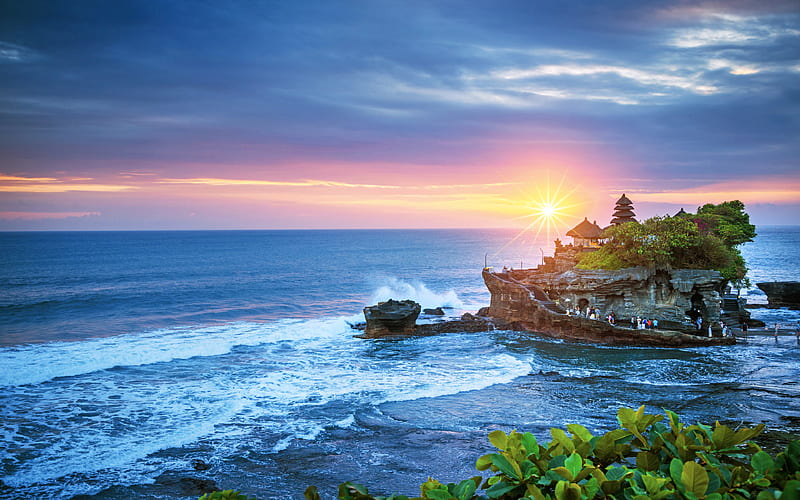
Tanah Lot Temple (Pura Pakendungan is the ancient name for Tanah Lot) dates back to the 15th century and sits gracefully on its little rock, waiting for the low tide so it can welcome Balinese worshipers.
Legend says, Tanah Loth Temple was built by Sanghyang Nirantha one of the last Brahman priests who arrived from Java and got plenty of followers very quickly. Bendesa Beraben, the local ruler, who was afraid of losing control, ordered the Nirantha to leave. The Newcomer then used his magical powers to split the rock that Tanah Lot is situated on, from the mainland. Nirantha also transformed his scarf into a holy snake, which nowadays still protects Tanah Lot. Eventually, and many years later, the old leader Beraben followed the newcomer Nirantha.
Pura Tanah Lot, is a very popular attraction in Bali. As Uluwatu Temple, Tanah Lot Temple also offers an unbelievable sunset and a lovely area to stroll around. During low tide, the rocky coast is the perfect place for kids to capture crabs and romp around. Ceremonies at Tanah Lot are spectacular and make the most fabulous postcard pictures. Check out the event calendar of Tanah Lot Temple, to make sure, it is possible to take an outstanding picture of a magical moment in Bali.
 Many shops and some Warungs can be found around Tanah Lot. The prices are reasonable and the sellers are not overly pushy. Some showmen offer everybody the opportunity to take pictures with monkeys or snakes for a small donation. Purah Tanah Lot guarantees every family a nice afternoon, and in the event of good weather, a gorgeous sunset as well.
Many shops and some Warungs can be found around Tanah Lot. The prices are reasonable and the sellers are not overly pushy. Some showmen offer everybody the opportunity to take pictures with monkeys or snakes for a small donation. Purah Tanah Lot guarantees every family a nice afternoon, and in the event of good weather, a gorgeous sunset as well.
Tip 1: Pura Tanah Lot is a very nice area for kids during low tide but please take care as the rocks can be slippery
Tips 2: Check out the event calendar and ask the staff at the hotel for the ceremony time to take the perfect postcard picture
Additional information 1: Tanah Lot is derived from the words Tanah (land) and Laut (ocean) which finally means offshore.
2. Bratan Temple and Lake in Bali (Pura Ulun Danu Bratan) – An outstanding Temple in outstanding scenery
Bratan Temple Bali (Pura Ulun Danau Bratan) is located on the shores of Bratan Lake in the Bedugul domain 1240 meters above sea level. A one-way trip from Kuta takes about 2 hours.
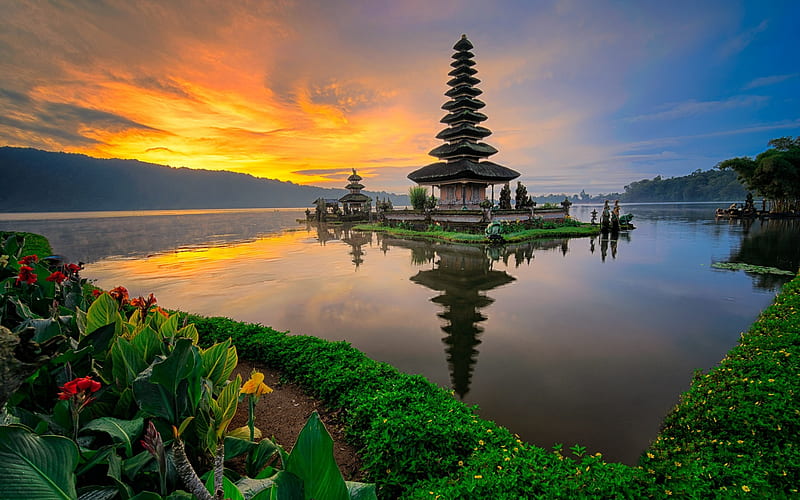
Bratan Temple was built by the King of Mengwi in 1633, who also built the water temple Taman Ayun. It is dedicated to the Goddess of Water Dewi Anu to ensure a successful harvest season with bountiful crops.
 Visitors will enjoy the complete Area around Bratan Temple as it is simply amazing, well-maintained and one of the most visited cultural highlights in Bali. Pura Ulun Danau Bratan area offers stunning postcard picture views and it’s the perfect place for long strolls and water sports activities. At Bratan Lake Temple Complex, all gods of the Triad (Trimurti) are honored (Brahma, Vishnu, and Shiva). A banyan tree shades the temple entrance and leads people through a wonderful garden. Pura Ulun Danu Bratan contains four different temples, referred to by the mentioned Gods.
Visitors will enjoy the complete Area around Bratan Temple as it is simply amazing, well-maintained and one of the most visited cultural highlights in Bali. Pura Ulun Danau Bratan area offers stunning postcard picture views and it’s the perfect place for long strolls and water sports activities. At Bratan Lake Temple Complex, all gods of the Triad (Trimurti) are honored (Brahma, Vishnu, and Shiva). A banyan tree shades the temple entrance and leads people through a wonderful garden. Pura Ulun Danu Bratan contains four different temples, referred to by the mentioned Gods.
1. Lingga Petak Temple – Siwa, the destroyer
2. Puncak Mangu Temple (Pura Pucak Mangu Temple – Bhatara Hyang Danawa or Wisnu, the protector and preserver
3. Teratai Bang Temple (Pura Teratai Bang) – Brahma, the creator of the universe
4. Dalem Purwa Temple (Palebahan Pura Dalem Purwa) – Bhatara Hyang Danawa or Laksmi Goddess.
Penataran Temple gets the most attention, it’s situated on a peninsula that juts out into the lake. Its 11-roofed Meru (pagoda-shaped shrines with a maximum amount of 13 roofs) can be seen on almost every Bratan Lake postcard.
Tip 1: Bratan Temple is a must-visit for every age. Kids can romp around, paddleboats can be rented and the scenery is simply magnificent.
Tip 2: Don’t forget to bring a jacket, it can get very cool up there!
Tip 3: Plan to stay there for a minimum of 1 ½ hours, it is worth it!
Additional Information 1: Merus is named after Mt. Meru, a sacred Hindu peak, considered for the gods.
3. Gunung Kawi Temple in Bali (Pura Gunung Kawi Bali) – A unique Temple carved into the mountain
Gunung Kawi Temple (Pura Gunung Kawi), another unique Balinese temple complex, carved into the mountain, which is located on Pakerisan River, close to the village of Tampak Siring and the Tampak Siring Palace in the regency of Gianyar.
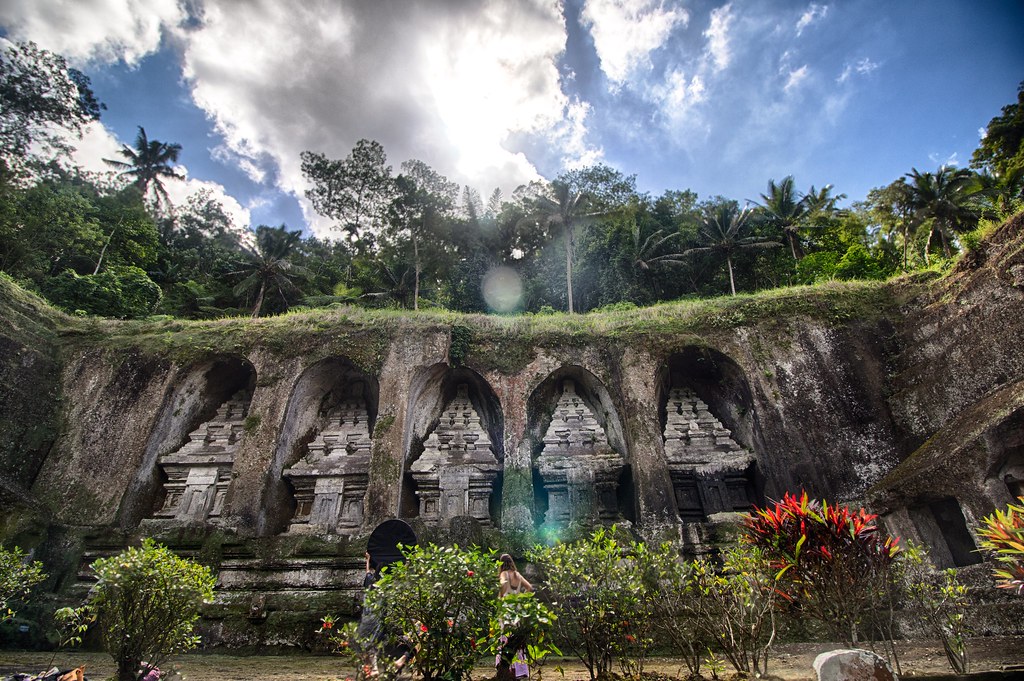
Gunung Kawi temple dates back to the 11th century and the creation was started by Raja Marakatapangkaja (reign: 1024 – 1028 AD) and then finished by Raja Anak Wungsu (reign: 1050 – 1077) who in the end gave up his kingdom to become a religious eremite. Another legend says that the monuments were carved out of the mountain by the Giant Kebo Iwo within one night.
 Pura Gunung Kawi bears a resemblance to the South American Mayan Temples as it is surrounded by a lush green tropical rainforest and situated on a mountain river. Each of the 10 seven-meter high niches in Gunung Kawi Temple is very popular and contains a different tomb dedicated to long-forgotten kings, additionally making this place both unique and incredibly spiritual. The tombs are spread within a distance of 1 km2 which means it takes a short relaxing stroll to see them all.
Pura Gunung Kawi bears a resemblance to the South American Mayan Temples as it is surrounded by a lush green tropical rainforest and situated on a mountain river. Each of the 10 seven-meter high niches in Gunung Kawi Temple is very popular and contains a different tomb dedicated to long-forgotten kings, additionally making this place both unique and incredibly spiritual. The tombs are spread within a distance of 1 km2 which means it takes a short relaxing stroll to see them all.
Tip 1: Gunung Kawi Temple is well worth the visit! It is highly recommended to go there, especially if art and/or culture are desired.
Tip 2: More than 300 stairs have to be managed, so only go there if a little exercise doesn’t sound too scary.
Tip 3: Nobody has to buy a sarong from the vendors in the shop area before the entrance, and borrow it at the ticket counter.
Tip 4: Leave enough time to try and find out the hidden meanings of all the carvings.
Additional Information 1: The complex was discovered by Europeans in the 1920’s even though they had arrived more than a decade ago.
Additional Information 2: Gunung Kawi is derived from the words gunung (mountain) and kawi (carving) – If we were to use the American Indian language, we could finally come up with a translation as follows “The Carvings which have been made into the mountain”! It makes sense, right?
4. Pulaki Temple in Bali (Pura Pulaki Bali) – A Temple with magnificent views
Pulaki Temple (Pura Pulaki Bali) is located in the western part of Buleleng Regency, close to Banyu Poh, a grape-growing village in the Grokgak sub-district and about a 3-hour drive away from Kuta (30 kilometers from Seririt and about 45 kilometers from Singaraja or Lovina.
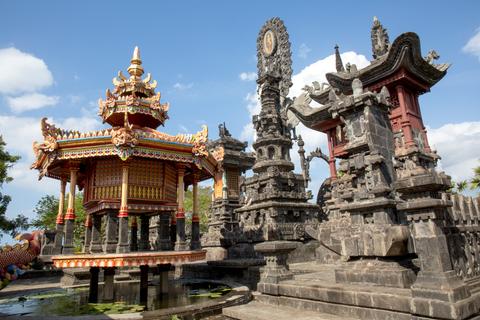
Pulaki Temple also commemorates the arrival of the Javanese saint-priest Nirartha in the early 16th century (Please see also Rambut Siwi Temple, Uluwatu Temple, and Goah Lawah Temple). It is said that when Dang Hyang Nirartha entered the forest of Pulaki he was escorted by plenty of monkeys. To give thanks to those monkeys who guided him, he established Pulaki Temple. In the end, the monkeys eventually became the guards of this temple. Also, Pulaki Temple was meant as a retreat for Nirartha’s beautiful daughter to prevent her abduction by the king.
 Pulaki Temple, the main temple of Permuteran, directly situated on the coastline, offers some magnificent views. It is divided into 3 courtyards and is dominated by black color. To enter the main court some stairs have to be climbed but they can be managed by everybody. Pulaki Temple is surrounded by two more temples. At Pura Pabean Temple local fishermen pray for a safe journey. At the foot of Pura Pabean is it possible to find Segara Temple, an older and very basic temple.
Pulaki Temple, the main temple of Permuteran, directly situated on the coastline, offers some magnificent views. It is divided into 3 courtyards and is dominated by black color. To enter the main court some stairs have to be climbed but they can be managed by everybody. Pulaki Temple is surrounded by two more temples. At Pura Pabean Temple local fishermen pray for a safe journey. At the foot of Pura Pabean is it possible to find Segara Temple, an older and very basic temple.
Tip 1: Buy some fruits and have the full attention of the macaques.
Tip 2: Check out the path in the upper part of the compound and get some even better views.
Tip 3: Banyu Poh Village is surrounded by vineyards and is the perfect area for a wine-tasting tour. Please ask the friendly hotel staff to get all the information that is desired.
Additional Information 1:
Nyegara Gunung is a place where the mountain is close to the ocean. The Balinese believe that these kinds of places have a special spirit.
5. Tirta Empul Temple in Bali (Pura Tirta Empul Bali) – A Temple built by a God
Tirta Empul Temple can be found (Pura Tirta Empul) to the north of Tampak Sering, about 1 kilometer away from Gunung Kawi Temple, about a 30-minute drive from Ubud.
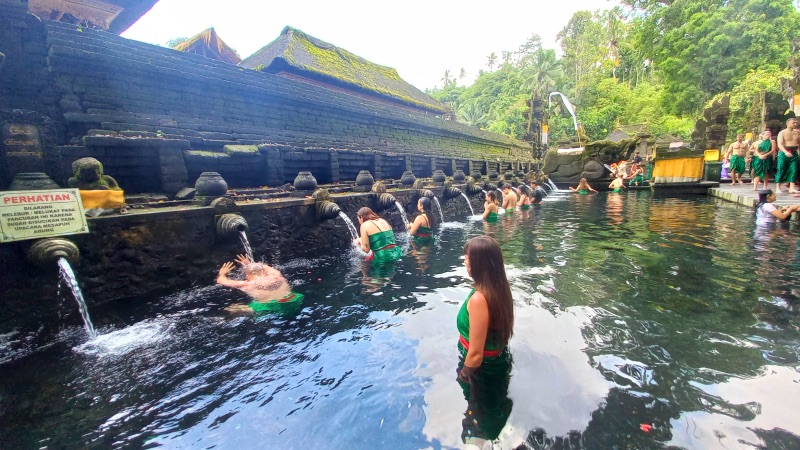
Tirta Empul Temple dates back to 926 AD (Warmadewa dynasty from the 10th to 14th centuries). Legend says that Tirta Empul Temple was built by the god Indra after his force was poisoned by Mayadenawa, the first (Demon-) King of Bali. Indra pierced the earth to revive his forces with the help of the fountain of immortality.
Pura Tirta Empul, which was fully restored in 1969, is nestled in a lush green environment making this Temple simply magical. To reach Tirta Empul Temple’s main attraction guests first have to stroll through the well-maintained gardens. One of Pura Tirta Empul’s main attractions, outside of the temple complex, is a carved pool, full of Koi fish.
Pura Tirta Empul is surrounded by a big wall to keep evil spirits at bay, its location is close to the Government Palace, enthroned on a hill in 1954. The crystal clear and fresh water inside the temple is supplied by 12 sacred spring fountains. The spring which supplies these fountains is also the source of Sungai Pakerisan (Pakerisan River). The bathing area is divided into 3 stone-carved sections to separate women from men and to also give the most pure the chance to be separated.
 Holy water still plays a very important role in Balinese religion. For this reason, the holy water of Tirta Empul Temple is considered to be one of Bali’s holiest and is even taken home by the locals. The Balinese still believe that the holy water of Tirta Empul Temple has not only magical but also healing powers. They also believe that water from Pura Tirta Empul ensures eternal youth.
Holy water still plays a very important role in Balinese religion. For this reason, the holy water of Tirta Empul Temple is considered to be one of Bali’s holiest and is even taken home by the locals. The Balinese still believe that the holy water of Tirta Empul Temple has not only magical but also healing powers. They also believe that water from Pura Tirta Empul ensures eternal youth.
Throughout the year, pilgrims from all over Bali meet at Tirta Empul Temple for their ablution. Before worshippers start to bathe and pray, they make an offering at the temple.
Tirta Empul Temple is well worth a visit and creates a true understanding of how religious the Balinese really are. It is sad but true that this impression can’t be achieved in the south of Bali anymore especially not in Kuta.
Restaurants and souvenir stands can be found outside of the temple complex.
Tip1: Buy some food and feed the Koi
Additional Information 1: Tirta is derived from the Sanskrit word “amrita” which means nectar or life elixir.
6. Taman Ayun Temple in Bali or Mengwi Temple Bali (Pura Taman Ahun) – The royal Temple of Mengwi
Taman Ayun Temple, also known as Mengwi Temple because it’s the Royal Temple of Mengwi, is located in Mengwi village and it’s sub-district, about 18km north of Denpasar the capital of Bali, in the regency of Badung. Taman Ayun Temple is located relatively close to all major tourist destinations in Bali such as Nusa Dua, Jimbaran, Kuta, Sanur, Seminyak, or Ubud and the drive from these destinations takes about 60 – 70 minutes.
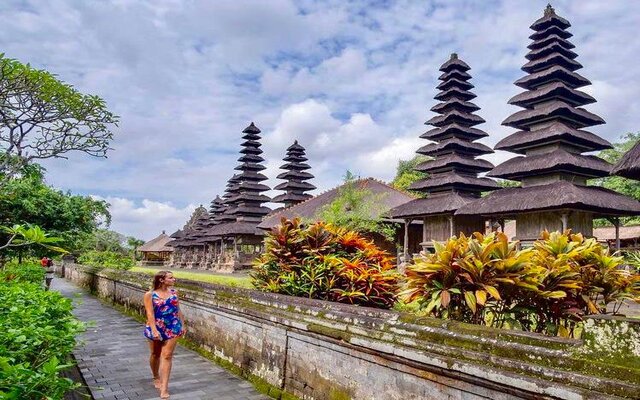
Referring to the Lontar Babad Mengwi, a very important historical chronicle for Bali, which was written on banana leaf paper, Mengwi Temple was both re-sanctified and re-named in 1634 to become the Taman Ahyun Temple.
 Taman Ayun Temple is simply a beautiful place to visit and it should be put on everybody’s day tour. The complex is surrounded by a wonderfully wide, well-maintained, and beautifully landscaped garden inviting visitors to go for a longer stroll to escape the hustle and bustle that takes place in the south of the island of the gods. The barbicans still carry a Kulkul, which is a traditional Balinese bell. The wonderful multi-roofed Balinese style Pagodas (Meru) make the perfect postcard picture view. The huge fish ponds that surround the complex make Taman Ayun look like the temple is floating on water.
Taman Ayun Temple is simply a beautiful place to visit and it should be put on everybody’s day tour. The complex is surrounded by a wonderfully wide, well-maintained, and beautifully landscaped garden inviting visitors to go for a longer stroll to escape the hustle and bustle that takes place in the south of the island of the gods. The barbicans still carry a Kulkul, which is a traditional Balinese bell. The wonderful multi-roofed Balinese style Pagodas (Meru) make the perfect postcard picture view. The huge fish ponds that surround the complex make Taman Ayun look like the temple is floating on water.
Taman Ayun Temple is well maintained and it’s a highly suggested place to visit during a vacation as well as being recommended for travelers of all ages and interests.
Additional Information 1: Only worshippers are allowed to enter the main complex
Additional Information 2: Taman Ayun means “founded in the park”
Additional Information 3: A Kulkul is a giant bell that is either made from wood or bamboo. Various social organizations of the Balinese society use this bell for an assortment of reasons. Obviously, as a bell, it is used to indicate a time of gathering or a ceremony and even in the past to alert the village during a time of conflict or criminal activity. The groups in Bali are segregated based on traditions, professions, or hobbies. The type of sound that is made from the Kulkul is different for each organization, therefore making it easy for the members to know which group is required. The Kulkul is traditionally made from certain wood such as the wood from a jackfruit tree, an orange tree, or other hardwood trees, and used to signal the traditional organizations. However, those made of bamboo are only for temporary use or only for the temporal groups.

